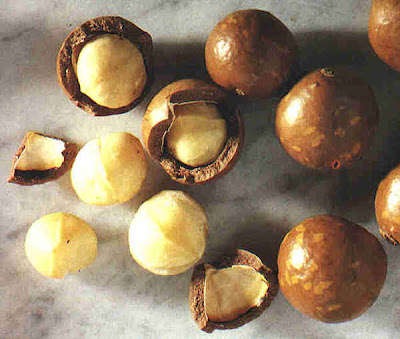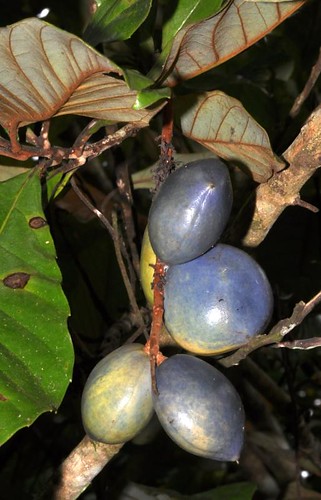Macadamia Nuts
|
They are commercially available. |
|
The nuts are low in saturated fats, high in mono and polyunsaturated fats and have high protein and dietary fibre. Traditionally used for their healing properties and as a food source. As of Feb 2024 production has ceased. |
|
Readily available in season (January/February) |
|
Not readily available and difficult to open apparently - that may change in the future |
There are no products listed under this category.

 Macadamia nuts grow encased in a hard, woody shell, which is protected by a green-brown fibrous husk. In its natural state a macadamia tree will have flowers, nutlets and mature nuts growing simultaneously, in profusion for much of the year. The nuts fall to the ground between March and September each year and are harvested by pin wheel harvesters at regular intervals.
Macadamia nuts grow encased in a hard, woody shell, which is protected by a green-brown fibrous husk. In its natural state a macadamia tree will have flowers, nutlets and mature nuts growing simultaneously, in profusion for much of the year. The nuts fall to the ground between March and September each year and are harvested by pin wheel harvesters at regular intervals. Sandalwood Nuts are native to Western Australia and tolerate long dry periods. Although the trees can live an estimated 250–300 years, plantations are now in cultivation to service demand leaving the old-growth sandalwood trees alone.
Sandalwood Nuts are native to Western Australia and tolerate long dry periods. Although the trees can live an estimated 250–300 years, plantations are now in cultivation to service demand leaving the old-growth sandalwood trees alone. Bunya Nuts are native to south-eastern Queensland especially the Bunya Mountains National Park. The bunya nut tree is a huge tree which bears a crop only after the tree itself is around 100 years old, and then it crops once every 2 or 3 years only. Football-sized green bunya pine cones are hidden in the tree canopy weighing 5-10 kilograms and containing between 30 and 100 nuts. The cones will fall from the tree when mature and should be harvested and frozen or processed within a week.
Bunya Nuts are native to south-eastern Queensland especially the Bunya Mountains National Park. The bunya nut tree is a huge tree which bears a crop only after the tree itself is around 100 years old, and then it crops once every 2 or 3 years only. Football-sized green bunya pine cones are hidden in the tree canopy weighing 5-10 kilograms and containing between 30 and 100 nuts. The cones will fall from the tree when mature and should be harvested and frozen or processed within a week. Atherton Almond (Athertonia diversifolia), also known as Atherton Oak, is a small to medium sized Australian native tree from the wet tropical rainforests of North Queensland. This is a relative of the Macadamia tree and produces blue fruits containing a woody shell with a large, crunchy edible nut.
Atherton Almond (Athertonia diversifolia), also known as Atherton Oak, is a small to medium sized Australian native tree from the wet tropical rainforests of North Queensland. This is a relative of the Macadamia tree and produces blue fruits containing a woody shell with a large, crunchy edible nut.